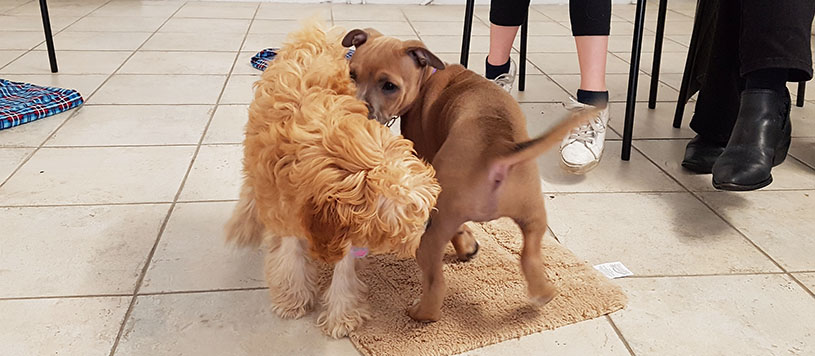Play is fun. We may still be in the dark about why dogs and other animals play, but I think we can be fairly confident that they get something out of it. Most young dogs routinely and eagerly engage in play and their body language is ridiculous when they do it. They throw themselves on top of one another and on the floor, they paddle and punch with their paws, they hang off each other’s ears with their teeth, they chase and invite being chased, they bow, bowl and bounce all over the place. In short, they seem to be having a ball.
I could stop right here, since this alone gives me reason enough to be an ardent supporter of dog-dog play. But, we can also assume that something as risky (think injuries) and energy-consuming as play could not have evolved if it didn’t equip the animals with some sort of advantage or – in evolutionary terms – improve their fitness. So, there must be more in it for the individual than just the thrill of letting their hair down.
We don’t know what animal play is for, but that doesn’t mean we can ignore it.
Animal play is a topic that has challenged researchers for a long time as there may well be more than one reason that play evolved. Evidence for the commonly held view that play might serve as practise for real life has so far been elusive. However, the lack of conclusive research to explain exactly why animals play does not mean we can dismiss play as a useless and irrelevant activity.
Here are some of the possible functions of play that have been put forward by researchers:
- Helps an animal cope with stress throughout development.
- Facilitates learning and creativity.
- Develops the cognitive abilities of an animal.
- Prepares the animal for unexpected situations.
- Increases emotional resilience.
- Is an opportunity for self assessment.
- Hones an animal’s physical skills.
- Is fun and therefore psychologically beneficial.
- Aids in the forming of lasting social bonds.
Even if we cannot fully explain the adaptive and proximate functions of play behaviour in animals, we have to assume it delivers benefits to the animal and is important for their welfare. As animal behaviour researchers Held and Spinka1 point out:
“if engaging in play strengthens some future somatic properties, enhances skills or widens competencies, then it also improves future animal welfare since the animal will be better able to withstand adversity, maintain health, reduce fear and achieve goals that will be sources of reward”.
The latest hypothesis that animal play prepares an individual for the unexpected2 and teaches them to recover quickly from loss of locomotion or sensory control is especially interesting. Watching puppies play does indeed seem like a string of mishaps such as being pushed over or falling over, losing balance, being pinned down, being jumped on, facing sudden role reversals and being barked or snapped at and so on. If this develops the puppy’s ability to quickly get back on their feet physically as well as emotionally, that is a good thing.
So, if play is beneficial for dogs, why would we not allow a puppy to engage in dog-dog play?
One reason someone may not allow their puppy to play is the fear the dog could be harmed, similar to the over-protectiveness in some parents of human children. This can be rooted in the personality of the owner but could also be a result of misinformation. As long as puppies are only exposed to other puppies and friendly adults and play sessions are properly supervised, the risk of receiving any sort of physical or emotional damage is tiny compared to the benefits. Incomplete understanding of what good dog-dog play looks like may also be to blame. Being knocked over, jumped upon and bitten on the neck (with inhibited bite force of course) is just as much part and parcel of normal dog play as self-handicapping and role reversals.
Each dog has a life of their own and we have no right to spoil it for them.
Not giving one’s dog access to social play with other dogs, especially during their juvenile and adolescent developmental periods, can affect the dog’s ability to cope with life outside their immediate family and make them less adoptable should they ever get into that situation. Intentional or not, this essentially ties the dog’s fate to that of their current owner. This is an unnecessary and potentially tragic situation.
I believe we have a responsibility to set our dogs up to successfully negotiate life in a society that includes humans, dogs, cats and other animals. The likelihood that a dog will encounter other dogs (and cats) during their lifetime is extremely high. Even if this does not include off leash encounters, a dog is more likely to be at ease, if they have a history of positive experiences with other dogs. Ethically, I believe we do not have the right to deny our dogs potentially crucial experiences which contribute to their future happiness. Anxiety can arise from many sources, not all of which we can control. But we can control our knowledge and compassion. Let’s do everything we can to make our dogs happy.
References and resources
1 Spinka M, Newberry R C & Bekoff M (2001) Mammalian Play: Training for the Unexpected. The Quarterly Review of Biology 76:141-168.
2Held S D E & Spinka M (2011) Animal play and animal welfare. Animal Behaviour 81:891-899.
Dugatkin L A. 2004. Principles of Animal Behaviour. 509-539.
 Copyright secured by Digiprove © 2017 Sylvie Martin
Copyright secured by Digiprove © 2017 Sylvie Martin 
